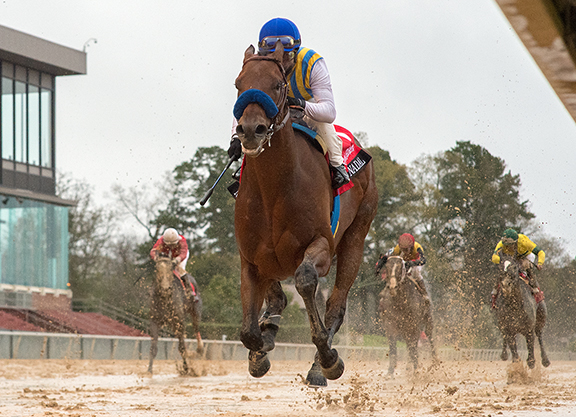By Chris McGrath
So that's why they had to split the GI Arkansas Derby. One division apiece for Kipling's “twin imposters,”–Triumph and Disaster.
Though we've all felt otherwise, from time to time, Lady Luck is as proportionate as she is indiscriminate in her dealings with Thoroughbreds. If Bob Baffert is better placed to absorb the loss of a servant as talented as Nadal (Blame), only a barn of such depth could have achieved the level of Triumph, in the first place, to have meanwhile registered a commensurate sequel of Disaster.
It's not the place of an idle bystander to presume how a Hall of Fame trainer received the consecutive bolts from the blue that this week struck his twin Oaklawn winners. Apart from anything else, the apparent violation that menaces Charlatan (Speightstown) with disqualification shouldn't even be in the public domain, pending a second test. Ignorance of the inside story, however, did not prevent us all from sharing Baffert's next disappointment, in the injury to Nadal–and not simply because we were all looking forward to learning which of his three meteors (not to neglect Authentic {Into Mischief}) would eventually claim the unbeaten record of the other two.
Because this is just the first big debit forced upon the whole sport, both now and when future generations go through the annals, by the postponement of the GI Kentucky Derby to September. No point, I guess, in reprising yet again how Churchill Downs lobbed that grenade, without consultation, into the rest of the calendar. We must now just be more grateful than ever that Nadal at least had the chance to contest a 9-furlong Derby on the first Saturday in May. The mental and physical maturity he displayed in Hot Springs might well have sufficed, in a normal year, to have won the race he would otherwise have contested that day.
Oaklawn's superior engagement with the sport's wider needs would arguably have been still more gratifying had they not diluted their Derby with a division. To whatever extent this may have reflected Charlatan's marginal claims to a gate–and clearly there were other valid factors–the upshot may now be the elevation of Basin (Liam's Map), thrashed six lengths into second, to formal parity with Nadal.
It's good to see that provision has been made, in the unlikely event of the GI Belmont S. being oversubscribed, for the final three berths to be determined by committee. Had Oaklawn been able to do the same, they might perhaps have ensured that a Grade I race remained as hard to win as possible, while still accommodating Charlatan. As it is, of course, he stands in danger of forfeiting 100 qualifying points for the Kentucky Derby.
Before that bank was menaced, but also before Nadal's injury, Baffert was talking about diverting Charlatan from the Belmont to the GI Woody Stephens S. You would imagine that plans might now change again, not least with a mile-and-eighth around a single turn offering 150 points to this exhilarating speedball. Whatever happens next, however, Baffert had been pretty candid about his reluctance to run his star sophomores against each other before absolutely necessary. And while that's a perfectly human instinct, it does magnify the penalty routinely paid by the sport for the rise of the “super-trainer.”
As it is, we'll never know now whether Nadal could have beaten Charlatan. And the sorry lack of national coordination in reconfiguring the post-lockdown calendar arguably means that we have no sophomore race at all, this year, where it will feel absolutely imperative for any sentient horseman to start his or her horse.
If NYRA dared to take a stand with the GI Travers S., indeed, they might even find some East Coast traditionalists sufficiently affronted by Churchill's behavior–trampling the precious heritage of so many other tracks–to say that a Travers at the usual time and distance is worth more than an ersatz Kentucky Derby in September. (If the Travers does take an earlier date, incidentally, then let's hope nobody is craven enough to cut back the distance as well. If we can't test the mettle of younger horses with the frantic schedule of a conventional Triple Crown, the very least we can do is to get relatively mature animals to run 10 furlongs twice in a month.)
Assuming that the unique kudos of the Derby is going to prove transferable, however, then the status even of the other Classics will become wholly contingent on the perceptions and commitment of individual horsemen. With the Maryland Jockey Club having in turn decided to reschedule the Preakness to its local benefit, halfway between the Derby and the Breeders' Cup, there appears to be a particularly precarious, self-fulfilling quality to the Belmont. And whether the race, in its temporary guise, can claw its way back into a “Triple Crown” series of bona fide Classics–as first rather than last leg–may depend pretty heavily on Maxfield (Street Sense).
Connections have legitimate reasons for considering the GII Toyota Blue Grass S. three weeks later, a more congenial stepping-stone towards the fall. He adored the track, for one thing, when announcing himself with that breathtaking move in the GI Claiborne Breeders' Futurity last year; and, having made his first start since only last Saturday, smashing straight into Tiz The Law (Constitution) might yet turn one step forward into two steps back.
What a step forward it was, however, in the GIII Matt Winn S. To think that only a week ago, in this same space, we were pondering whether Nadal and Major Fed (Ghostzapper) might end up running down the Derby stretch even as their namesakes contested that Majors record at Flushing Meadow. As it was, Major Fed served up the equivalent of four double-faults; and Nadal is off to stud. No wonder Kipling, facing those twin imposters, implores us always to “fill the unforgiving minute, with 60 seconds' worth of distance run.”
Not a subscriber? Click here to sign up for the daily PDF or alerts.






